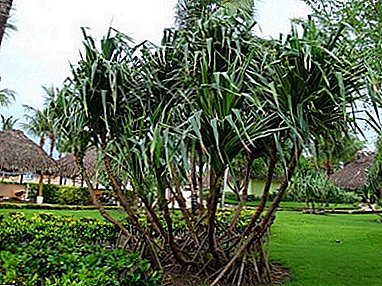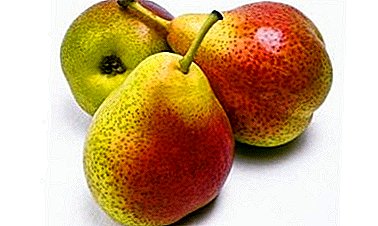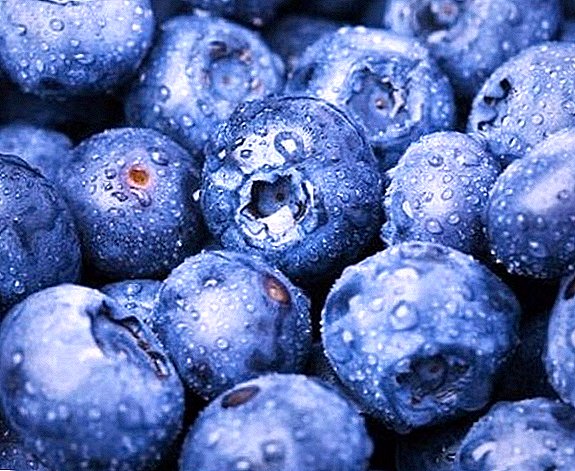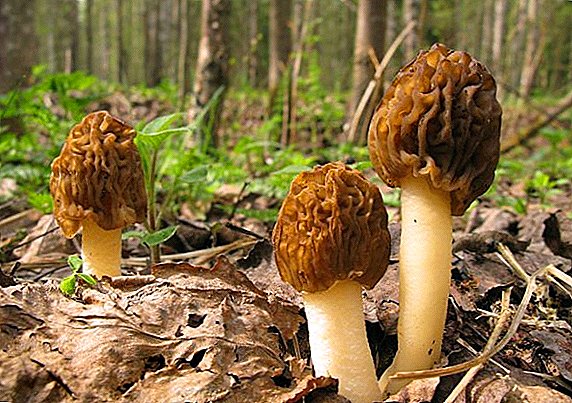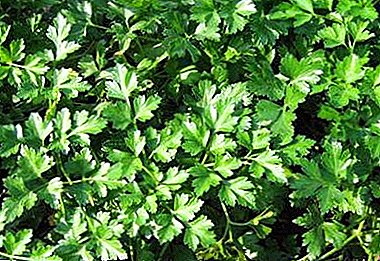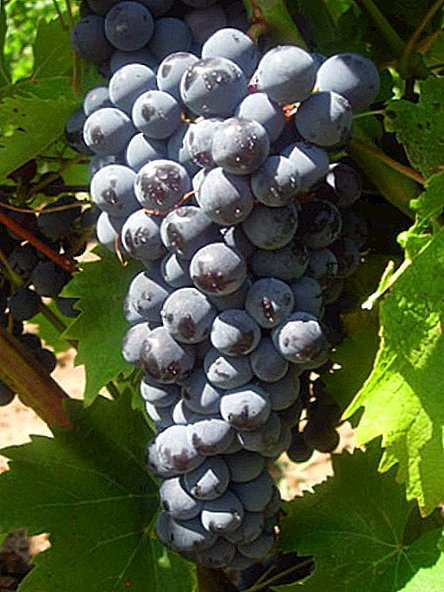 Today, a modern breeding school knows many varied and fragrant grape varieties. These cultures are able to fully satisfy all the desires of the consumer, as well as production needs. However, not each of them can boast of a long history, as well as a real healing effect - this is what the Black Doctor grape is like. In the article we will look in detail how to properly grow this pearl of winemaking and what technical qualities this variety has.
Today, a modern breeding school knows many varied and fragrant grape varieties. These cultures are able to fully satisfy all the desires of the consumer, as well as production needs. However, not each of them can boast of a long history, as well as a real healing effect - this is what the Black Doctor grape is like. In the article we will look in detail how to properly grow this pearl of winemaking and what technical qualities this variety has.
Other variants of the name
The Black Doctor grape variety appeared more than 2 thousand years ago on the territory of modern Armenia and to this day has not only survived, but also gained immense popularity among winemakers around the world. That is why for its long history, he received several names.
Did you know? Grape is one of the oldest crops. Humanity was engaged in active cultivation and breeding of this plant as early as the Neolithic period, about 6-8 thousand years ago.
Initially, the ancient inhabitants of the Armenian Highlands, this plant was called "Ekim Kara", which means "Black Doctor" in Turkish.
This name for this variety was chosen for a reason: a variety of products from its berries contain many vitamins and nutrients that positively affect the human body and health. Over time, the plant spread beyond the Armenian Highland, which undoubtedly affected the transformation of its name.  Therefore, to the inhabitants of the southern regions, as well as to the peoples of the Black Sea region, these grapes are known as Kefesia or Kefé raisins. Today, these names are synonymous, so each of them means the same fragrant berry.
Therefore, to the inhabitants of the southern regions, as well as to the peoples of the Black Sea region, these grapes are known as Kefesia or Kefé raisins. Today, these names are synonymous, so each of them means the same fragrant berry.
Check out the cultivation of such technical grape varieties as Viorica, Krasnostop Zolotovsky, Alpha, Isabella, Malbec, Chardonnay, Cabernet Sauvignon, Riesling.
Characteristics of a variety
"Black Doctor" has a high varietal characteristics. Despite the fact that this grape almost did not yield to artificial selection, it can easily compete with many modern hybrids.
In addition, the "Black Doctor" has improved taste, which turns the drinks from its fruit into a truly unique product. 
Grade assignment
Kefé raisins are a technical grape variety. The berries of this plant are most often used for the preparation of wines and other alcoholic beverages. In addition, it is not rare that this variety is used as a raw material for the production of juices, compotes, fresh juices, jams, jams and other products, such as raisins.
Grade acidity
Berries varieties are characterized by quite tangible sourness. 1 liter of pure grape juice contains about 6-7 g of various acids (tartaric, citric, malic, succinic, oxalic, etc.). This one is approximately 3.5-4 pH.
Sugar variety
The number of sugars in 100 ml of berry juice averages about 21.5 g.  In particularly favorable and productive years, the sugar content may increase, up to 24-26 g / 100 ml of juice.
In particularly favorable and productive years, the sugar content may increase, up to 24-26 g / 100 ml of juice.
Bunch shape
The clusters often have a regular cylindrical or cylindrical shape, of medium size and density.
The composition of the bunch:
- pulp -87%;
- ridges - 5.2%;
- peel - 5.9%
- seeds - 19%.
Did you know? According to ancient Russian mythology, the forbidden fruit in paradise were not apples, but grapes.
Bunch weight
The total mass of the average cluster is not large and reaches 160-200 g. In high-yielding years, its weight can increase, up to 300 g. 
Berry Shape
The berries have a regular rounded shape, but sometimes it can change to slightly oval. The diameter of the average fruit does not exceed 15-20 mm.
Berry weight
Berries "Black Doctor" differ in low weight. The weight of one berry on average reaches 3-5 g.
Color of berries
Fruits of a grade differ in a saturated dark shade. These are mainly varieties of dark blue, blue-violet flowers, down to characteristic blackness. On top of the skin is covered with a slight pale bloom, which brightens the overall shade of the berries.
Taste
The taste of the grapes is quite bright and recognizable: it is characterized by a sweet, slightly tart flavor, resembling prunes or cherries. 
Ripening
The ripening period of this variety is average (about 140-145 days from the beginning of the growing season), but under the conditions of the southern climate, the grapes can ripen earlier (130-135 days from the beginning of the growing season).
Yield per hectare
The yield of the variety is average and is about 10 t / ha.
Many are looking for answers to such questions: whether to care for grapes during flowering, how to grow grapes from chubuk and bones, how to transplant and not damage the grapes, how to graft and grape properly.
Frost resistance
"Black Doctor" refers to frost-resistant plants. This grape is able to safely withstand prolonged temperature drops, down to -23 ° C. Therefore, in some southern regions, this plant does not need a special shelter for the winter. 
How to care and how to plant grapes
Proper and qualified care for grapes is the main condition for obtaining high yields. This process does not require a huge baggage of specialized knowledge, as the grapes grow in almost any conditions with enough heat and free moisture.
But in order to get a really high-quality crop with high taste characteristics, the care of the plant should be given special attention.
Time for seedlings of grapes
The favorable period for planting grapes comes 2 times a year, in early spring and late autumn. In spring, the optimum period for planting is the end of March, and in the fall, grapes are planted from October until the first frost. The agrotechnology of this process is the same regardless of the season. 
Planting grapes begins with a preliminary preparation of the soil for planting, for this:
- The final stage of soil preparation is abundant irrigation with 50-60 liters of water. In the case of autumn planting - the plant is planted in the soil in 2-3 weeks after preparing the holes, if planting is planned in the spring - the plot is left alone until the next season.
- Deep holes dug 80 x 80 x 80 cm in size are dug out of the plot, from which native soil is completely removed.
- The bottom of the hole is covered with a drainage layer of gravel or small pebbles 10-15 cm thick.
- At a distance of 10-15 cm from the edge of the hole, a small plastic pipe with a diameter of 5 cm is installed directly into the drainage layer. The upper edge of the pipe must be 10-15 cm above the ground level.
- After that, the hole is filled with chernozem in several layers (10-15 cm each), which are carefully tamped. 150 g of potash fertilizers (potassium sulfate, potassium sulfate or potassium magnesia) and about 200 g of superphosphate should be poured over each layer.
The main stages of planting grapes:
- Over the next few weeks the plant will be acclimatized. At this stage, they should be kept under a plastic bottle dome until they are used to new conditions. Watering seedlings produced directly into the drainage layer through a plastic pipe. After the plants reach the mature age, the pipes are removed, and further watering is performed by the surface method.
- Planting grapes begins with the preliminary preparation of seedlings - for this they are soaked for 1-2 hours in an aqueous solution of clay (the liquid must have a creamy consistency).
- A small mound of chernozem is poured in the center of the prepared hole, after which a small hole should be made in it (according to the size of the root system of the seedlings).
- Next, seedlings are planted in the soil, while the plant buds should be strictly directed to the north, and the root heel - to the south.
- If necessary, to level the level of the soil in the hole, you need to fill up a mixture of black earth and sand (1: 1).
- Next, planted plants must be sure to cover the dome of a 5-liter plastic bottle with a cropped neck.

Important! If the grapes are planted in sandy soil, the size of the hole must be increased to 100 x 100 x 100 cm.
Time to clean the grapes
Vine peeling is a must-have for obtaining rich crops. Elimination of excess shoots makes it possible to create plants of the correct and convenient form for care, and also helps to direct all the forces of the plant organism to the formation of fruits.
In addition, cleaning is the physiological need of grapes for fruiting. The fact is that the fruit clusters on the plant are formed exclusively on young shoots, which are derived from last year's branches.
There are only two approaches for the implementation of this procedure: the so-called autumn and spring cleansing. Spring cleaning is carried out before the beginning of the active growing season, when the average daily temperature is reached + 5-10 ° C. Autumn cleaning is carried out immediately before hibernation, after harvest.  The optimal time for carrying out this procedure in the autumn depends on the climatic features of the growing region:
The optimal time for carrying out this procedure in the autumn depends on the climatic features of the growing region:
- in a subtropical and tropical climate, plants are cleaned after leaves fall;
- in the northern climate, grapes are pruned after the first frosts, during the period of short-term thaw;
- in temperate or colder climates, the grapes are pruned a week before the shelter, cutting off not only the green shoots, but also the leaves.
Learn more about how to prune grapes in spring, summer and autumn.
Today there is no consensus about which of the purges is more correct and expedient. However, spring pruning is often preferable, as pruning grapes in the fall can significantly weaken the plant, which directly affects its resistance to seasonal temperature drops.
Video: Step by step pruning of grapes Summer cleaning is also worth mentioning. It is carried out in the middle of summer, 2-3 weeks after feeding plants. At this stage, the vine is stepson, minted, and dry branches are removed on it, as well as leaves, shielding clusters of berries from sunlight.
Whichever method of cleaning you choose, when pruning grapes you should always follow these rules:
- It is not recommended to shorten shoots with a diameter of more than 2 cm (with the exception of dead branches), since the wounds that have arisen often heal for a very long time, which negatively affects the development of the bush;
- cleaning should be done on a sunny day;
- for fruiting, only annual shoots should be left, which are located on biennial branches;
- on the bush should be no more than 2 mature shoots emerging from the base of the plant;
- when pruning a one-year shoot, the cut is performed 2-3 cm above the node, the cut angle is directed to the opposite side from the eye;
- when shortening the long-term shoot, the cut is performed no higher than 1 cm after the node, and its angle should be directed perpendicular to the axis of the shoot;
- after removing the stepson, the height of the stump should not exceed 0.5 cm;
- during the rejuvenation of the sleeve is not recommended to shorten the shoots that are located between the two wounds.

When and how to harvest
"Ekim Kara" refers to varieties with an average term of fruit ripening, therefore the period of harvest of these grapes comes often in the middle of October. By this time, the berries are fully gaining the necessary sweetness and juiciness, as well as all sorts of useful substances.
It will be helpful for you to read about when and how to collect grapes.
The most distinct sign of ripeness of berries is their unique dark shade. To fully ensure the ripeness of the crop, you should definitely look at the additional signs of ripeness of the fruit.
These include the following:
- easy lignification of the stalks of grapes;
- the skin becomes thin and soft;
- berry seeds become brown in color and are well separated from the pulp;
- the berries acquire a rich taste and aroma, and also lose their sharp acidity.

Did you know? To make 1 bottle of wine from grapes, you need about 600 berries.
Basic harvesting rules:
- picking berries is done by hand using a garden pruner or scissors;
- cut the clusters neatly, holding the berries behind the stem;
- the harvest should be harvested in hard and stable containers (baskets, buckets, etc.), this will help to protect the berries from damage;
- substandard grapes need to be rejected on the spot; to do this, take care of a separate container for them;
- It is not recommended to wash off wax deposits during harvesting, as this negatively affects their safety and transportability.
Important! All the grapes should be collected from the plot, as its remains can attract wasps, which pulls along a lot of additional problems.

Diseases and disease control measures
The grade "Black doctor" belongs to plants, steady against various infectious diseases. However, in rare cases, this grape may be affected by the following ailments:
- anthracnose - A fungal disease that causes damage to leaves, shoots, inflorescences and fruits. The disease manifests itself in the form of brown spots with a yellow border, which gradually merge into one and hit the plant with dotted areas. To eliminate the pathology, the plant is treated with the following fungicides: "Antracol", "Acrobat", "Ridomil", "Thanos", "Horus" or analogues;
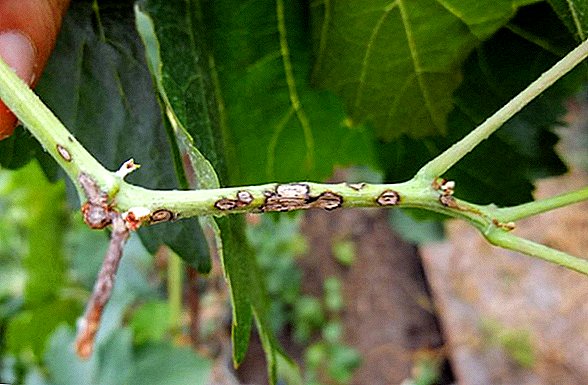
- powdery mildew - an infectious fungal disease, which is manifested by a mealy bloom of a grayish-white color, with a large-scale lesion, the ailment causes the death of the inflorescences and leaves, as well as the cracking of the berries. They combat powdery mildew with the help of the following fungicides: "Strobe", "Thanos", "Tiovit", "Topaz", "Horus".
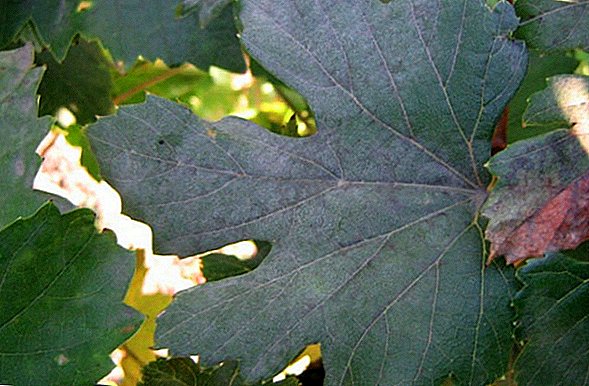
- mildew (downy mildew) - fungal disease, which manifests itself as oily spots on the leaves. After some time, the spots develop into a light mealy bloom, which causes rotten necrotic lesions, as well as falling leaves, buds and flowers. Eliminate the downy powdery mildew by treating the affected plants with the following preparations: Antracol, Kuproksat, Ridomil, Strobe, Thanos, Horus.
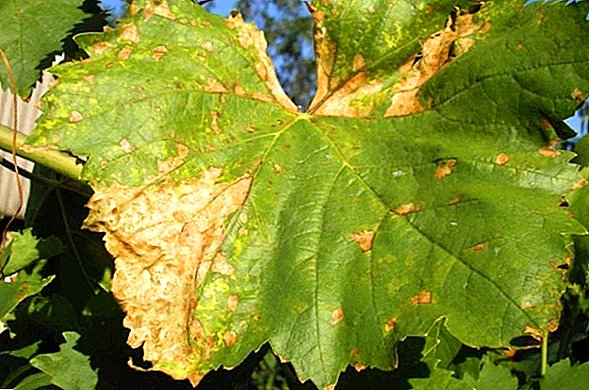
We advise you to read about how to prevent and combat diseases and pests of grapes.
Important! In order to prevent the development of any infectious diseases on the grapes, the plants must be cut, and 2 times a year (before flowering and after the formation of berries) process Bordeaux liquid or complex fungicides.
The healing properties of grapes
Grapes "Ekim Kara" is a real source of all kinds of healing substances and vitamins. Since ancient times, products from this variety have been actively used to normalize the activity of the organism, and also as a general tonic.
You will certainly be interested to learn about the beneficial properties of grapes.The effect of grapes "Black Doctor" on the human body:
- choleretic effect - is actively used to treat a variety of liver pathologies;
- analgesic effect - used to relieve joint pain and muscle spasms;
- improves digestion and metabolism - used in the treatment of constipation;
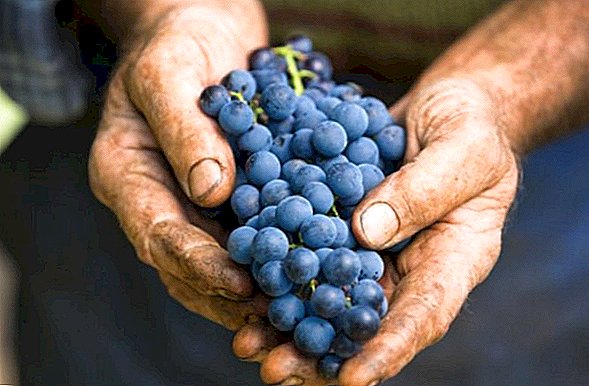
- increases the tone of the cardiovascular system - used in the treatment of varicose veins and vascular blockage;
- reduces blood pressure - used in the treatment of hypertension;
- antitumor effect - used for the prevention of cancer;
- tonic effect - used to increase the resistance of the immune system during the spread of seasonal infectious diseases.
Grape application
The black doctor is a wine grape variety, so its berries are actively used to make dessert wines and other wine beverages. Such products often have a medicinal effect on the body, a characteristic aroma, elasticity and chocolate flavor.
We recommend reading about the best grapes for wine, as well as learning how to make wine from grapes at home.
The most common brands of such products are Black Doctor and Black Colonel wines. "Black Doctor" is a unique grape variety, which for more than 2 thousand years of its history has not only been able to spread almost all over the world, but also to preserve its uniqueness and authenticity.  This variety does not surprise with its early ripeness and record-breaking yield, but its wine products have a real healing effect. In order for the plant only to be pleased with the harvest and high-quality drinks, it needs to create a comfortable environment for growth, as well as ensure regular cleaning.
This variety does not surprise with its early ripeness and record-breaking yield, but its wine products have a real healing effect. In order for the plant only to be pleased with the harvest and high-quality drinks, it needs to create a comfortable environment for growth, as well as ensure regular cleaning.






